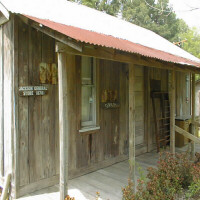| SEARCH
THIS SITE
|
 |
|
HOME
. |
. |
Camilla Post Office.....Camilla, as a community, is a product of the reconstruction days that followed the Civil War. The Camilla Post Office was established in 1985, housed in a side room of Jim McMurrey's general store until the store burned. A new post office building was built in 1927 and served the community until the 1950's when the postmistress, Miss Bessie Hale, retired and the Coldspring Post Office took over the duties of sorting mail and Camilla became a rural route.
In 1984 Mrs. Trapp gave the building to the Historical Commission/Heritage Society with the stipulation that the interior walls remain as is, with all Miss Bessie Hale's writings on the walls, etc. The old Camilla Post Office now serves the county as a postal museum and is located in Old Town. The schoolhouse was usually the center and focus of rural communities and small towns. Sunday (Sabbath) school classes and church services (meetings) were held in the school house. Elections (vote/poll) and township meetings were held here as well. The school building also served as a grange hall, assembly hall, tax office, place for dances and box suppers, quilting bees and the like.
During the time of the one room school, often enough, one of the students would graduate, come back in three or four years with a certificate and become the new teacher. After four weeks of training, those who were to become teachers were given a test and certified to teach. This Waverly Schoolhouse
was donated by Mr. Harold French and moved to historic Old Town Coldspring
in 1983.
 The
old Jackson store was moved in the 1980's from the Magnolia community outside
of Evergreeen on FM 945. The original building was known as a 'box'
structure and was in such bad condition that it could not be restored.
In its original location, it was the hub of the area, selling any product
needed in a home or on a farm. They also stored and weighed cotton, ground
corn and cane, made caskets and housed the local post office. The
current building on the grounds, now called the 'New Jackson Store' is
a replica, built in 1991. The
old Jackson store was moved in the 1980's from the Magnolia community outside
of Evergreeen on FM 945. The original building was known as a 'box'
structure and was in such bad condition that it could not be restored.
In its original location, it was the hub of the area, selling any product
needed in a home or on a farm. They also stored and weighed cotton, ground
corn and cane, made caskets and housed the local post office. The
current building on the grounds, now called the 'New Jackson Store' is
a replica, built in 1991.
The general store is perhaps the most interesting development in merchandising institutions. Unique to the developing frontier, very few similar institutions are to be found anywhere else in the world. The old time general store distributed a variety of dry goods hardware, groceries, drugs and even liquors. It would serve as a post office, a shipping depot and as a village center where the local men could meet. An old box stove, a rickety chair or two, a few merchandise barrels and a sawdust split box were the almost universal furnishings for any general store of that day. Here politics and religion were discussed. While it may or may not be a profitable venture, it was still a vital part of any community. |